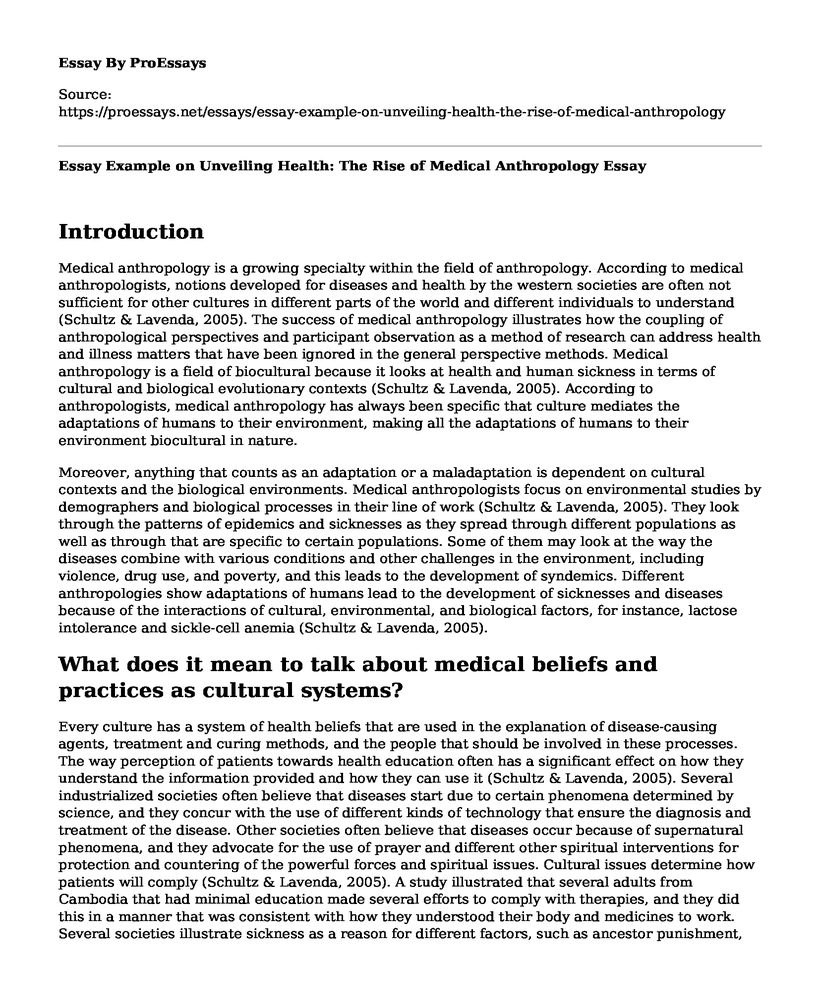Introduction
Medical anthropology is a growing specialty within the field of anthropology. According to medical anthropologists, notions developed for diseases and health by the western societies are often not sufficient for other cultures in different parts of the world and different individuals to understand (Schultz & Lavenda, 2005). The success of medical anthropology illustrates how the coupling of anthropological perspectives and participant observation as a method of research can address health and illness matters that have been ignored in the general perspective methods. Medical anthropology is a field of biocultural because it looks at health and human sickness in terms of cultural and biological evolutionary contexts (Schultz & Lavenda, 2005). According to anthropologists, medical anthropology has always been specific that culture mediates the adaptations of humans to their environment, making all the adaptations of humans to their environment biocultural in nature.
Moreover, anything that counts as an adaptation or a maladaptation is dependent on cultural contexts and the biological environments. Medical anthropologists focus on environmental studies by demographers and biological processes in their line of work (Schultz & Lavenda, 2005). They look through the patterns of epidemics and sicknesses as they spread through different populations as well as through that are specific to certain populations. Some of them may look at the way the diseases combine with various conditions and other challenges in the environment, including violence, drug use, and poverty, and this leads to the development of syndemics. Different anthropologies show adaptations of humans lead to the development of sicknesses and diseases because of the interactions of cultural, environmental, and biological factors, for instance, lactose intolerance and sickle-cell anemia (Schultz & Lavenda, 2005).
What does it mean to talk about medical beliefs and practices as cultural systems?
Every culture has a system of health beliefs that are used in the explanation of disease-causing agents, treatment and curing methods, and the people that should be involved in these processes. The way perception of patients towards health education often has a significant effect on how they understand the information provided and how they can use it (Schultz & Lavenda, 2005). Several industrialized societies often believe that diseases start due to certain phenomena determined by science, and they concur with the use of different kinds of technology that ensure the diagnosis and treatment of the disease. Other societies often believe that diseases occur because of supernatural phenomena, and they advocate for the use of prayer and different other spiritual interventions for protection and countering of the powerful forces and spiritual issues. Cultural issues determine how patients will comply (Schultz & Lavenda, 2005). A study illustrated that several adults from Cambodia that had minimal education made several efforts to comply with therapies, and they did this in a manner that was consistent with how they understood their body and medicines to work. Several societies illustrate sickness as a reason for different factors, such as ancestor punishment, sorcery, and witchcraft. Biomedicine in developed nations often rejects these kinds of explanations majorly because of how they regard humans as unified, self-contained, and autonomous organisms. They only consider the material causes of the disease within the human body (Schultz & Lavenda, 2005). However, there are several other communities in developed nations that do not agree with the biomedical point of view about themselves and things that cause human suffering. Groups such as evangelic Christians understand that the causes of different forms of suffering are evil spirits that penetrates the body. Evangelical Christians also emphasize the importance of prayer, and they see these as a pathway for communication to God. Some researches illustrate that the form of prayer is a skill that is learned and often enhanced by spiritual discipline that is recognized by different religious traditions. Analyses developed often see that the prayers learned by the Christians often changed the way their minds worked, and this change was mostly seen to be the voice of God (Schultz & Lavenda, 2005). People take these experiences positively as opposed to the voices of people who have schizophrenia hear. Biomedicine has also illustrated the experiences that divided selves are due to mental disturbance; however, this experience is seen to be a regular and benign experience. This is not only seen in non-developed communities but also the developed communities as they see the internet as a Second Life (Schultz & Lavenda, 2005).
Reference
Schultz, E. A., & Lavenda, R. H. (2005). Cultural anthropology: A perspective on the human condition (Vol. 1). Oxford University Press, USA.
Cite this page
Essay Example on Unveiling Health: The Rise of Medical Anthropology. (2023, Jul 12). Retrieved from https://proessays.net/essays/essay-example-on-unveiling-health-the-rise-of-medical-anthropology
If you are the original author of this essay and no longer wish to have it published on the ProEssays website, please click below to request its removal:
- How Sleep Affects People's Lives Essay
- Diversity in the Nursing Workforce - Research Paper
- Compare and Contrast Essay on Pelvic Inflammatory Disease and Benign Prostatic Hypertrophy
- Paper Example on Sibling Death in ICU: Problem Stated & Research Built
- Essay Example on Diagnosing Mental Health Disorders: Examining Behaviours and Symptoms
- Eating Out During COVID-19: Is Takeout & Delivery Safe? - Essay Sample
- Paper Sample on Bottled Water: Safety, Health & Taste Misconceptions







